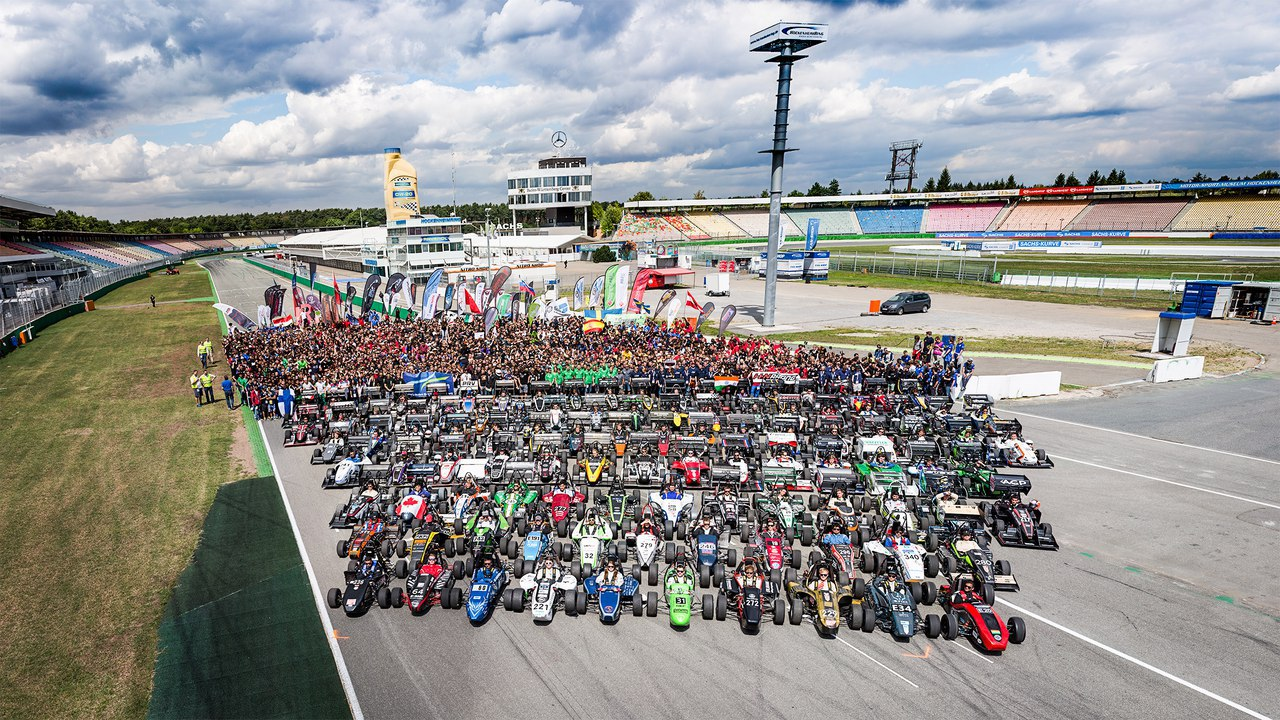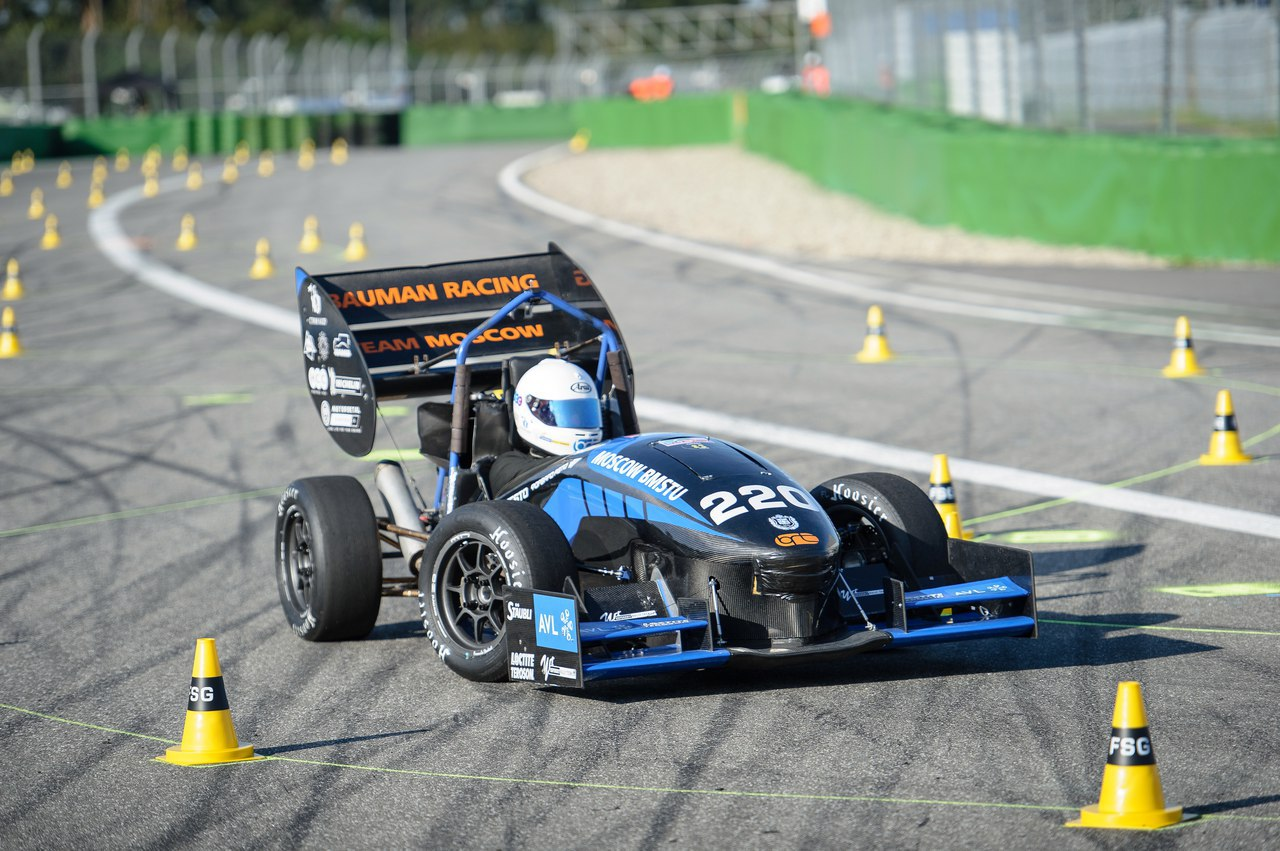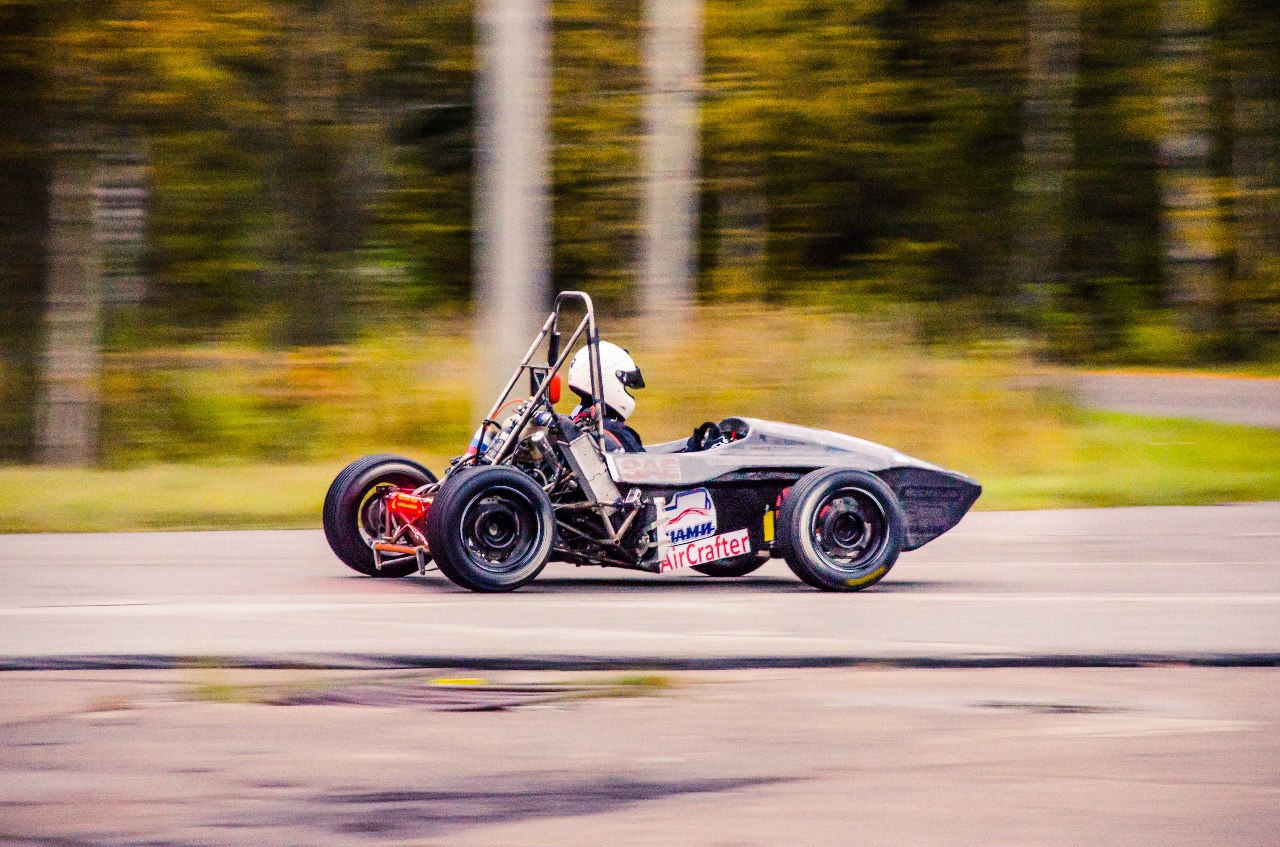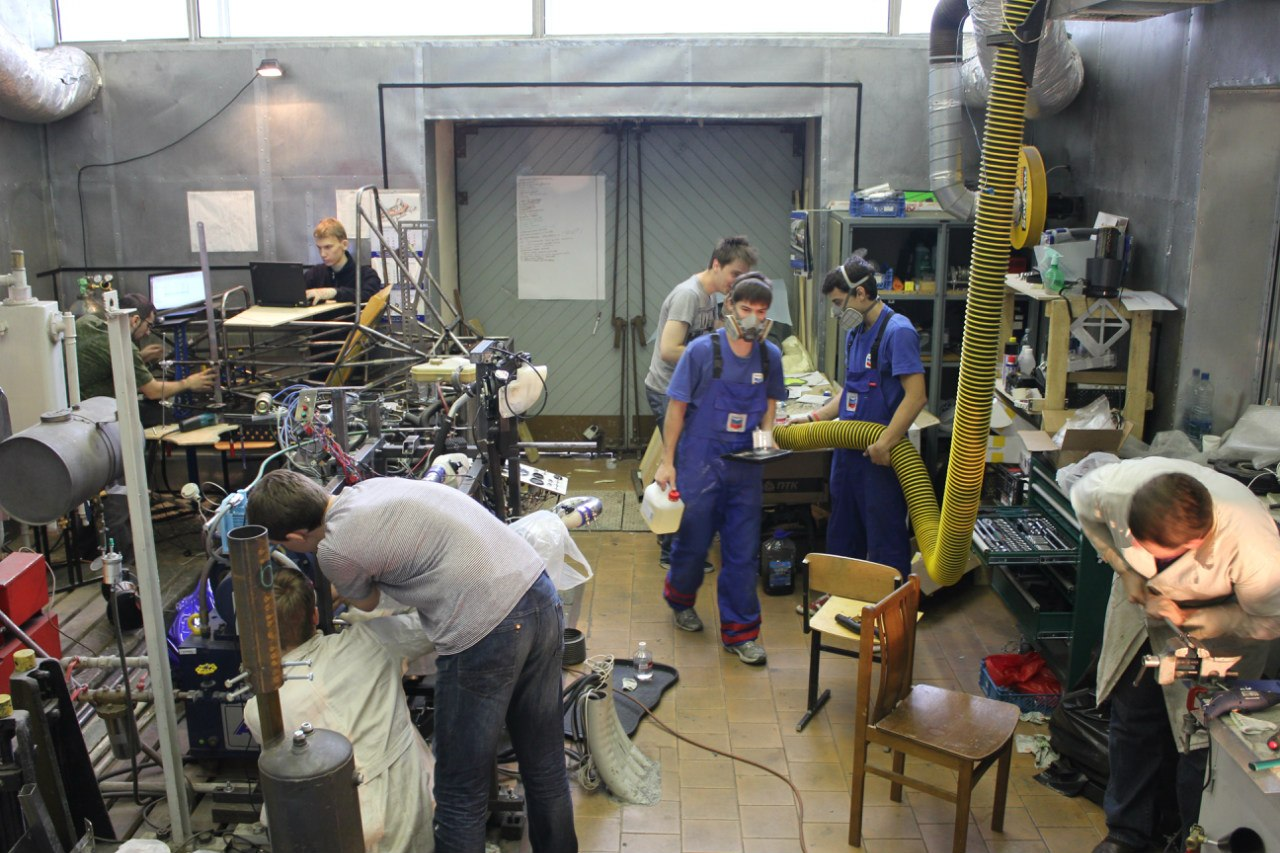It would seem that a common race for speed cars, MGTU Bauman and Lenovo? It's simple: the students of one of the best technical universities of Russia create amazing cars from scratch and compete in them in the Formula Student competitions. A Lenovo ThinkStation workstation and ThinkServer server help children simulate the details of future cars.

From buggy to drone
Formula Student is a large-scale competition from the USA. We can say that it began with fun races on buggy made of lawn mowers, the races on which for the sake of entertainment were organized by students of three American universities. This case is very much liked the professor of the University of Houston, Mark Marshek. Together with the Society of Automotive Engineers USA, he decided to make the activity more ambitious.
And he did it: in 1978, the first competitions were held on the basis of the University of Houston, which became the prototype of the modern Formula Student. This, by the way, is a European name, in America it is called Formula SAE. Years passed, the student Formula became more popular, and in 1998, in the UK, European competitions began to be held on the same rules.
Well, by now, teams of hundreds of different universities from dozens of countries of the world are participating in Formula Student races. In Europe, the most prestigious stages are considered to be stages in Germany (at the Hockenheimring stadium, where the F1 Grand Prix of Germany is held, by the way!), Italy and England. In the latter, everything also happens at a very significant place for fans of a great Formula 1 - on the track near the village of Silverstone. Here they usually hold the British Grand Prix. There are also competitions not included in the official series. In Europe, these are Spain, Hungary, Estonia and Finland.
 Before starting on Formula Student Germany 2016
Before starting on Formula Student Germany 2016In addition to fireballs with internal combustion engines, from which once everything started, now there are competitions in other classes in the Formula Student. For example, on cars with hybrid and electric engines and even on unmanned vehicles. But the good old ICE, of course, still remain the most popular.
Russian universities do not remain aloof from the international movement. Their teams have at MSTU. Bauman, PFUR, MADI, MAMI, Moscow and St. Petersburg Polytechnic Universities, children from Tyumen, Tolyatti, Yekaterinburg, Nizhny Novgorod and other cities come to the competitions. Well, just in the vastness of our vast country, there are more than 20 teams participating in the Formula Student competitions. Not everyone can still build a new car every year, because not only a lot of time and effort is needed, but also finance: all the pleasure costs between 5-6 and 10 million rubles for the racing season. But for the Baumanki team, this is so far successful.
 Pilot of the Bauman Racing Team in the race at the Hockenheimring Stadium
Pilot of the Bauman Racing Team in the race at the Hockenheimring StadiumMoreover, recently there is also the Russian Formula Student stage, which, however, is also not included in the qualification series.
Regulations above all
What is the difference between Formula Student and Formula 1? First of all, the fact that this is not a commercial, but an educational project. All team members (including even racers) must be students. Secondly, the race itself is only a small part of the competition, the engineering component is put at the head of everything. The key idea here is that each team is a design office that must develop, build and test a non-professional formula-type car in a series of tests.
There is a set of sacred rules - technical regulations, from which in no case can not retreat. According to him, for example, the engine volume of a car cannot exceed 710 cubic centimeters, a frame and a monocoque must be designed in a certain way, air consumption is limited by a restrictor of a certain area, and so on. This was done not to make the life of the students more difficult, but to create conditions of maximum safety for the riders. For four decades of the existence of the Formula Student, there has not been a single fatal accident.
 The welded steel frame will soon be replaced with a carbon monocoque (as suspension arms and aerodynamic elements).
The welded steel frame will soon be replaced with a carbon monocoque (as suspension arms and aerodynamic elements).In addition, the very nature of the race is different. Formula Student cars are more compact and agile, the radii on the tracks are rather small. There are no restrictions on the number of cylinders in the engines, but, given the other introductory, there is no such thing that, say, four-cylinder will certainly win. On the contrary, it is often more rational to use 1 or 2 cylinders. Perhaps the car and will not come to the finish line the very first, but it will gain additional points on the test engine efficiency.
By the way, you already guessed that in a trend here are engines from sport motorcycles? They may not have many “horses” on their passport, but with an average car weight of 190-250 kg, they easily disperse cars to a hundred or more in 3-4 seconds.

The competitive part of the "Formula Student" consists of several static and dynamic disciplines. Among the first are the presentation of the business plan of the car, the design presentation and the justification of the economic efficiency of the project. They can bring the team up to 75, 150 and 100 points respectively. The dynamic part consists of five more tests: acceleration (maximum - 100 points), controllability (75), autocross (125), fuel efficiency (100) and the race itself, for which you can get up to 275 points. The maximum possible number of points for all disciplines - 1000, but this number, of course, no one ever gains.
Much more than just a learning project.
Team "Formula Student" in Moscow State Technical University. N. E. Bauman exists five years. Right in the year of the creation of the Bauman Racing Team, the guys were able to design their first BRT-1 car, and went with it to Italy. We did not win (from the first time, few people manage to win prizes), but they showed themselves with dignity and gained invaluable experience. Since then, the “new year - new car” concept has followed and continues to regularly participate in the qualifying and non-qualifying stages of the “Formula Student”.
The team is large: as a rule, about 50 people work in the main team. There is a captain, chief engineer, heads of departments involved in certain parts of the car. For example, suspension or brake system. Of course, it does not do without humanitarian support - the Bauman Racing Team has a lot of tasks for economists, managers and PR-specialists. In fact, the occupation is easy to find for a student of any faculty.
 Part of the Bauman Racing Team (from left to right): Alexander Kolomiets (suspension), Sergey Vansky (supporting systems and welded structures), Ivan Borisenko (power units)
Part of the Bauman Racing Team (from left to right): Alexander Kolomiets (suspension), Sergey Vansky (supporting systems and welded structures), Ivan Borisenko (power units)Creating a race car is not only exciting, but also useful. Many students defend term papers or even dissertations on this project. And graduates of the Moscow State Technical University, who founded the Formula Student team 5 years ago, have now successfully completed their studies and went further: they are now engaged in the creation of the serial Roadster "Crimea". Already there is a working prototype of the future car, on the approach of the second, and in general, mass production is not far off. Moreover, there are no analogs on the world stage. Of course, many now matured participants of the Formula Student found work in BMW, Audi and other reputable car companies, but none of them had projects like Crimea.
At the beginning of each new academic year, the Bauman Racing Team conducts an advertising campaign among first-year students. The team is replenished with dozens of new members; by the end of the year, only the most hardworking and result-oriented remain. And the next year, they become mentors for new first-year students. Since only active students can participate in competitions, the backbone of the team should be constantly updated.
When the design and creation of the car is completed, and he himself safely tested, it is placed in a special truck, and the team - in a mobile laboratory. That’s how the Bauman Racing Team, consisting of 25-30 people, goes to competitions in Europe. The most difficult thing is to go through customs. Problems occur even when the documents on the equipment and the car are all right. For example, last year, students stumbled on the Belarusian-Polish border almost all day due to the fact that they had too many new tents. The customs officers did not believe that they would spend the night in a camp near the highway, and decided that it was a small wholesale lot for sale.
Thousands of parts in SolidWorks
It is surprising that there is a Bauman Racing Team mainly due to sponsorship. At university, the guys have a spacious room in which they can work. Inside, everything is serious: there is a garage, a welding shop, a 3D printing area, a room for working with composite materials, etc. - in a word, everything is really like in any serious design bureau.


Financial sponsors are the least, most companies help the Bauman Racing Team with equipment and materials. Someone brings new tires, carbon fiber and oil, someone allows you to use their machines. A separate pool of sponsors shares its equipment with the guys - among them just we, Lenovo. In 2015, we presented the Bauman Racing Team with our ThinkStation C20 workstation with a monitor and ThinkServer TS140. Their high computational power allowed the team to significantly accelerate the design and modeling processes.
Ivan Borisenko. Engineer Design Engine“On Lenovo ThinkStation and ThinkServer, we do everything from 3D modeling of a racing car to performing all sorts of engine capacity calculations in Ansys software packages and many other applications.”
The guys are working in the program SolidWorks (in the near future plans to switch to Siemens NX), and the size of the models with which they usually encounter is usually quite large. Files of individual parts weigh several gigabytes, and a complete set of all models for creating a future car takes dozens of gigabytes of disk space. The size of the total archive of finished models exceeds 500 GB, and previous iterations have to be regularly accessed.
The timing of the development of the car is strictly regulated - students simply do not have extra time. For example, in order to get to the qualifying stage of the “Formula Student” in Germany, you need to send a video of how the car is traveling on the road to a strictly certain day to a strictly defined time. Even one second lateness automatically negates all previous efforts. Plus, there is always a learning process in the background. The university does not give indulgences, and there are a lot of tasks and tests during design. So to create a racing car on a slow computer is absolutely impermissible.
Here to help and come good computing power Think Server TS140 and ThinkStation C20. Inside the workstation is an Intel Xeon E3-1245V3 processor and NVIDIA Quadro K2000 graphics accelerator. With assemblies SolidWorks, in which from several hundred to 1000 parts, such a computer copes without any problems and works quite well even with larger projects.
In addition, the Bauman Racing Team laboratory has one ThinkPad notebook, which is used to control the Faro coordinate measuring machine. Accuracy in creating parts of a racing car is very important, so one cannot do without such a device.
Good achievements and big plans

Bauman Racing Team is considered one of the best national teams participating in the "Formula Student". The guys won twice in the Russian stage of the competition and regularly take places in the top ten European stages in the tests for maneuverability and the protection of the design project. The main goal for the near future is to get into the TOP-20 of the most rated European stage - in Germany. It seems to us that with such a serious approach to business, this is absolutely real. We sincerely wish the guys success and prizes!